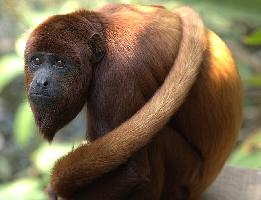
Váhy a míry
| Délka | od 52 do 70 cm |
|---|---|
| Hmotnost | od 3 do 9 kg |
| Délka ocasu | od 61 do 80 cm |
Biologická data
| Délka života | od 15 do 20 let |
|---|---|
| Délka březosti | 190 d |
Popis zvířete
The Colombian red howler, scientifically known as Alouatta seniculus, is a captivating species of howler monkey, one of the largest New World monkeys, that primarily inhabits the rainforests of northern and central South America. This species is particularly notable for its striking coloration and its loud, resonant howling, which can be heard up to three miles away in the dense forest, serving as a means of communication within groups and to ward off rival troops.Characterized by its robust and somewhat prehistoric appearance, the Colombian red howler has a dense fur coat that ranges in color from deep russet to a vibrant red, depending on the individual and its geographical location. This distinctive coloration not only provides them with camouflage amidst the verdant foliage but also plays a role in social signaling among members of the species. Males tend to be larger than females, with a more pronounced coloration, and can weigh up to 9 kilograms (about 20 pounds), whereas females usually weigh less.
One of the most fascinating aspects of the Colombian red howler is its diet, which is primarily folivorous. They feed on a variety of leaves, along with fruits, flowers, and occasionally nuts and seeds. This herbivorous diet requires a specialized digestive system to process the tough plant material, resulting in a large and extended belly that houses a complex stomach for fermenting the vegetation they consume. This adaptation allows them to extract maximum nutrients from their diet but also makes them relatively sedentary animals, as the digestion process is slow and energy-consuming.
The social structure of the Colombian red howler is intriguing, typically consisting of small groups that include one or two adult males, several females, and their offspring. These groups maintain a strict hierarchy, with a dominant male leading the troop. Communication within and between these groups is vital and is facilitated by their extraordinary vocalizations. The males possess an enlarged hyoid bone near their vocal cords, which acts as a resonance chamber to amplify their howls. These vocalizations play a crucial role in territorial defense, mate attraction, and in maintaining the cohesion of the group.
Reproduction in Colombian red howlers follows a polygynous pattern, where the dominant male mates with several females in the group. Females give birth to a single offspring after a gestation period of about six months. The young are cared for primarily by the mother, with weaning occurring around one year of age, although they may remain dependent on their mothers for a few years until they reach maturity.
The Colombian red howler monkey plays a critical role in its ecosystem as a seed disperser. Through its diet, it contributes to the regeneration of the forest by spreading the seeds of the fruits and plants it consumes, which in turn helps to maintain the biodiversity of its habitat.
Despite their significant ecological role, Colombian red howlers face several threats, primarily from habitat destruction due to deforestation and land conversion for agriculture and livestock farming. They are also hunted for food and captured for the pet trade in some areas. While they are not currently listed as endangered, their populations are in decline, and conservation efforts are essential to ensure their survival. Protecting their natural habitats and implementing sustainable land-use practices are crucial steps in preserving this remarkable species for future generations.
Nové fotografie zvířat
Top 10 zvířat
- Dolphin gull (Leucophaeus scoresbii)
- Diana monkey (Cercopithecus diana)
- Moustached guenon (Cercopithecus cephus)
- Galápagos tortoise (Geochelone nigra complex)
- Japanese macaque (Macaca fuscata)
- Stone loach (Barbatula barbatula)
- Russian tortoise (Testudo horsfieldii)
- Greek tortoise (Testudo graeca)
- Common flying dragon (Draco volans)
- Vendace (Coregonus albula)